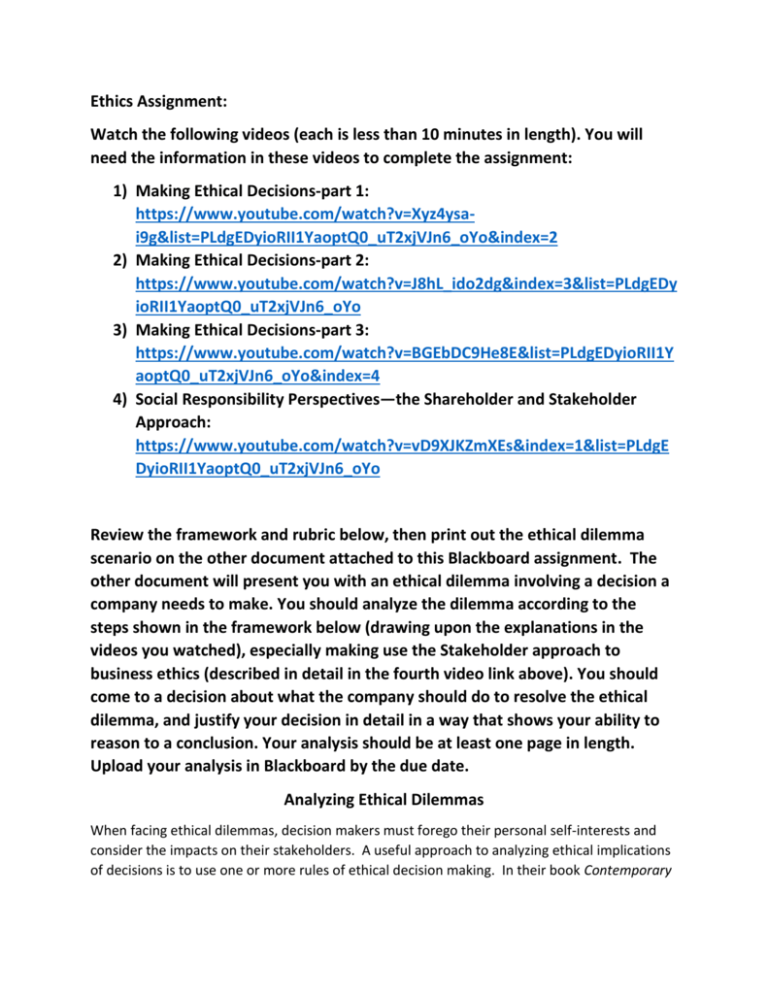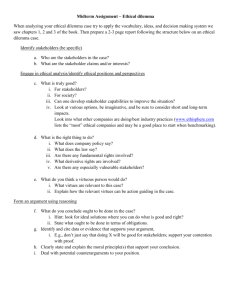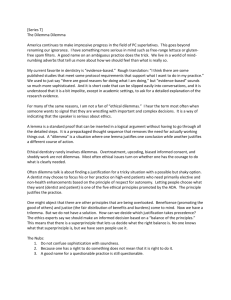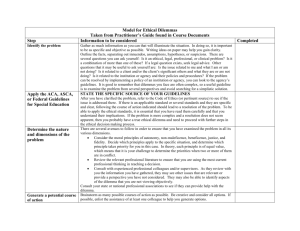ethics_assignment--instructions_and_rubric
advertisement

Ethics Assignment: Watch the following videos (each is less than 10 minutes in length). You will need the information in these videos to complete the assignment: 1) Making Ethical Decisions-part 1: https://www.youtube.com/watch?v=Xyz4ysai9g&list=PLdgEDyioRII1YaoptQ0_uT2xjVJn6_oYo&index=2 2) Making Ethical Decisions-part 2: https://www.youtube.com/watch?v=J8hL_ido2dg&index=3&list=PLdgEDy ioRII1YaoptQ0_uT2xjVJn6_oYo 3) Making Ethical Decisions-part 3: https://www.youtube.com/watch?v=BGEbDC9He8E&list=PLdgEDyioRII1Y aoptQ0_uT2xjVJn6_oYo&index=4 4) Social Responsibility Perspectives—the Shareholder and Stakeholder Approach: https://www.youtube.com/watch?v=vD9XJKZmXEs&index=1&list=PLdgE DyioRII1YaoptQ0_uT2xjVJn6_oYo Review the framework and rubric below, then print out the ethical dilemma scenario on the other document attached to this Blackboard assignment. The other document will present you with an ethical dilemma involving a decision a company needs to make. You should analyze the dilemma according to the steps shown in the framework below (drawing upon the explanations in the videos you watched), especially making use the Stakeholder approach to business ethics (described in detail in the fourth video link above). You should come to a decision about what the company should do to resolve the ethical dilemma, and justify your decision in detail in a way that shows your ability to reason to a conclusion. Your analysis should be at least one page in length. Upload your analysis in Blackboard by the due date. Analyzing Ethical Dilemmas When facing ethical dilemmas, decision makers must forego their personal self-interests and consider the impacts on their stakeholders. A useful approach to analyzing ethical implications of decisions is to use one or more rules of ethical decision making. In their book Contemporary Management, Jones and George (2014) identify the following “Rules for Ethical Decision Making”: Utilitarian Rule: An ethical decision is a decision that produces the greatest good for the greatest number of people. Moral Rights Rule: An ethical decision is one that best maintains and protects the fundamental or inalienable rights and privileges of the people affected by it. Justice Rule: An ethical decision distributes benefits and harm among people and groups in a fair, equitable, or impartial way. Practice Rule: An ethical decision is one that a manager has no reluctances about communicating to people outside the company because the typical person in a society would think it is acceptable. (pp. 113-114) Consider answering the following questions in evaluating an ethical dilemma: Step 1: Identify the issues surrounding the situation—facts of the situation, moral/ethical issues, major stakeholders. Step 2: State the alternative actions that could be taken and identify possible impacts on stakeholders. What other facts are needed or would be valuable in making a thorough analysis? Step 3: Apply one or more of the “Rules of Ethical Decision Making” to each of the alternatives. What are the potential consequences of each possible course of action? Rate the strength of each argument. Step 4: State your course of action with detailed justification. Consider the following evaluation rubric when constructing your analysis. Reference Jones, G. R., & George, J. M. (2014). Contemporary management, 8th ed. New York, NY: McGraw-Hill Irwin. (over) Analyzing Ethical Dilemmas TRAIT Unacceptable (0-1 pts.) Has a vague idea of what the dilemma is and is uncertain what must be decided Acceptable (2-3 pts.) Identifies the dilemma, including pertinent facts, and ascertains what must be decided Exemplary (4-5 pts.) Describes the dilemma in detail having gathered pertinent facts. Ascertains exactly what must be decided Identifies Stakeholders and How Dilemma Impacts Them Is unsure which stakeholders are involved and/or impacted Identifies some stakeholders and how they are involved in and/or impacted by the dilemma Identifies most stakeholders and explains in detail how they are involved in and/or impacted by the dilemma Analyzes Alternatives and Consequences Based on an Ethical Rule or Model Begins to appraise the relevant facts and assumptions and identifies some alternatives. Clarifies at least two alternatives and predicts their associated consequences Clarifies alternatives and evaluates each on the basis of whether or not there is interest and concern over the welfare of all stakeholders, possibly bringing in outside experiences/knowledge to bear on the problem. Chooses an Action Has difficulty identifying an appropriate course of action from among alternatives Formulates an implementation plan that delineates the execution of the decision Formulates an implementation plan that delineates the execution of the decision and that evidences a thoughtful reflection on the benefits and risks of action Identifies Dilemma






